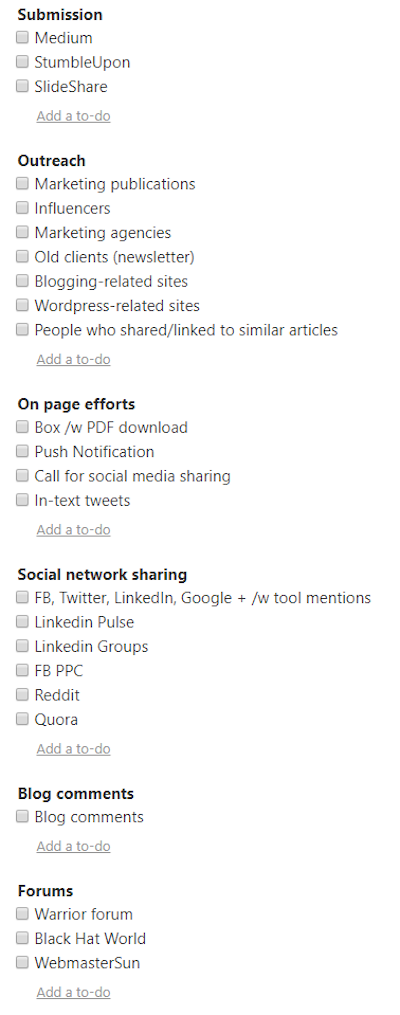Showing top 0 results 0 results found
Showing top 0 results 0 results found


How many times did you have a great content idea you forgot about days or weeks later? How many times did you have to reschedule a post because something more important came up?
Everyone reading this probably knows that one of the best ways to grow your business is through content marketing. More than 75% of marketers look to increase their investment in content marketing.
Do you think you can keep up with them without a long-term plan?
Sooner or later you will reach a tipping point - a situation where you won’t be able to produce content with high enough quality on a regular basis.
A perfect solution for your troubles is the content marketing calendar.
Among its numerous benefits we will discuss below, there is one that is often overlooked - it provides accountability.
Even if you make a task to create a piece of content, without assigning it to someone and giving it a due date, it will never be a priority and probably won’t live to see the light of day. That obviously isn’t a sustainable model that can support your content marketing strategy. Interested in finding out how to get the most out of your content marketing calendar? Scroll away!
Editorial calendar vs content marketing calendar
Before we go any further, it is important to make a distinction between a regular editorial calendar and a content marketing calendar.
Your first association for an editorial calendar is probably a picture of a calendar with topics and authors written in on the dates when a piece is scheduled to go live. And you would be completely right.
A content marketing calendar is much more than that.
The difference hides in the word content. Content envelops more than just written pieces on your blog. Infographics, quizzes, newsletters, video tutorials - it comes in all shapes and sizes.
With that said, and with the notion that you’re using the content marketing calendar with clear long-term goals in mind, it shouldn’t be a surprise that it is more complex than an editorial calendar.
As different teams have distinctive needs and workflows, you can find various content marketing calendar templates out there.
Here is a template we use at Point Visible. It contains most of the information you will find in a standard content marketing calendar.

Note that we use this template in combination with a project management tool to assign and track content development process in more detail as well as to coordinate all promotional activities.
You can go even further than that.
While you are creating the plan of action, use this chance to define guidelines that will span across all content pieces you plan to publish:
- language style; use of memes and gifs
- the overall tone of voice
- graphic design style you aim for
- branding guidelines (how to reference company name, use of company logo and brand colors…)
We recommend that you take a few templates out for a test drive to see what works best for you.
Content marketing calendar is a content managing marvel
The best way to show how important it is to have a content marketing calendar is to present you with different situations in which it can be an irreplaceable asset.
1. Managing your own content
If you don’t think that you need a plan to manage your own content, you just aren’t aware of all the things you can do with it.
Let’s say you have a long-form content, some sort of an ultimate guide like our review of the best outreach tools on the market. This type of content has to be regularly updated if you want it to stay relevant. And take my word for it, these are often complicated updates involving different team members, and they have to be planned ahead.
Another great example is working on a series of connected articles that cover a particular topic like this Beginner’s guide to social media from MOZ. Keeping up with the schedule on a project like this can be really challenging.
You can also update older posts, revamp old content, recreate previously published content in another form (infographic into a blog post and vice versa), incorporate interactive content into your publishing schedule and the list goes on.
2. Dealing with guest contributions
Guest contributions can be a great way to fill up your email marketing calendar and increase the number of content pieces you publish every week. However, those pieces still need to be discussed, reviewed, edited, published and promoted.
Additionally, if you want to have a good track record among your contributors, you can’t take 3 months to review their work (excluding high authority sites for obvious reasons).
It gets pretty hard to stay on top of everything if you don’t plan ahead.
3. Planning and managing content promotion
Content promotion is an integral part of the content lifecycle. Content that didn’t reach your target audience doesn’t bring much value.
If you want to ensure that everything goes smoothly, you need to develop a promotion plan. That plan is influenced by the resources you have and by the type of content you’re producing. Content marketing calendar can be a bridge between production and promotion.
If you don’t think think that you need a plan to manage your promotion, you are probably unaware of all the promotion channels you could be using. Here is an example of our promotion efforts for the outreach tools article mentioned above.

Now, I’d like to see anyone tracking promotion progress for multiple content pieces at the same time without planning ahead.
4. Having a clear overview of content you’re producing
Eight blog posts and one infographic scheduled for the next two months. When was the last time you did a social media contest that worked so well in the past? Isn’t it time to spice things up with more interactive content?
If you are afraid that you are becoming boring and predictable, these metrics can give you a clue to how justified your fears are:
- low engagement on social media (comments, likes, retweets)
- increasing number of “unfollows” and a hard time acquiring new followers
- high bounce rate
Keep in mind that the same metrics could point to the fact that you are just targeting wrong people or concentrating on wrong pain points so make sure you know your target audience.
Don’t let yourself become boring and predictable - use content marketing calendar to mix things up.
5. Following up on news and trends in your industry
I want to show you a quick example. Let’s say that you know that Content Marketing Institute publishes statistics on habits of top content marketers every year around October and you plan to create some content around it.
If you wait for too long, someone else might cover it before you. Additionally, every week you wait, the content becomes less relevant and appealing (especially if you are a part of a fast moving industry like the tech industry).
If you only had a place to allocate resources for it ahead of time!
Even if you found yourself in the position that you want to cover some ground-breaking news you didn’t see coming, having a content marketing calendar will make it that much easier to schedule it in without significantly delaying your other responsibilities.
6. Preparing and scheduling time sensitive content
Who doesn’t want to leverage holiday season to market his brand? We definitely do and that’s why we always plan ahead for such occasions.
Depending on the type of business you have and the event you are covering, you might want to:
- create interesting blog posts and/or infographics
- send appropriate newsletters
- prepare interactive campaigns like quizzes or social media contests
- update your logo
- prepare graphics for sharing on your social media channels
If you want to be completely prepared, search for appropriate online courses. For example, LiveChat offers a Black Friday Course that might come in handy very soon.
If you leave everything for the last minute, you might be swamped with work you can’t reschedule and miss the opportunity to engage your audience with theme-appropriate content.
7. Planning content for all stages of the marketing funnel
Customers won’t lead themselves through your marketing funnel. You need to have different content that you can use to engage them with depending on the phase of the funnel they are in.
If you didn’t set up your marketing funnel yet, content marketing calendar is a great way to plan and manage everything on the content production side.
8. Introducing new content managing approaches
Let’s say you decide to start developing your content around monthly themes. If you want to stay on schedule, you have to plan several months ahead. Do you honestly believe you can manage it without a proper content marketing calendar? The same goes for practically any other method.
Organize and use your content marketing calendar
If you want to take full advantage of your content marketing calendar, the first thing you need to understand is that this isn’t a one-man show but a team effort.
The usual lineup includes (but is not limited to):

To avoid bottlenecks and missed deadlines, every team member needs to know what is their task and the due date for that assignment.
As with any team activity, the key to success is team communication.
We found out that tracking everything through a project management tool was the simplest and most effective solution.
Let’s say we assigned Anita the task to create in-text graphics for our new blog post. She has to wait until the content is written before she can start working on the design. When the draft is ready, the writer can tag her to let her now the piece is ready and leave a link to their work.
It might seem simple at first sight but you have to keep in mind that you’ll often have content that goes through several iterations or is sliced up into multiple milestones. This is where you need a proper tool to keep track of your content development progress.
Before we move onto the next chapter, I want to leave you with one more useful tip.
You are using content marketing calendar to plan your content creation and promotion weeks and months ahead. But before any of that can take place, you need to have an idea what you want to cover.
The inspiration for your content can come from multiple sources and if often likes to strike when you’re in the middle of doing something completely unrelated.
That’s why it is really important to have a place where you can leave those ideas before they slip your mind.
For example, we have a Google Docs Spreadsheet where anyone can leave their suggestions at any time. The “required” fields are working title and a short description with an option to leave a link to the resource that inspired them.
Plan a realistic publishing frequency
You invested a lot of time to create a content marketing calendar and get your team on board. Now you’re itching to produce a ton of content right off the bat.
Before you start with the mass production, get to know your limitations. Review the available resources: number of writers and designers at your disposal, number of promotion channels you will be using, the budget you can allocate for promotion, and probably the most important thing of all - the time your team can set aside for this purpose.
The best way to safely test your limitations is to start slowly and gradually increase the tempo. Your team gets familiar with the workflow, content quality doesn’t drop, and you’re finally delivering content to your audience on a stable schedule.
It also helps if every team member tracks how much time they spent on their part of the job. After a couple of months, you should have a decent sample and you’ll be able to deduce the average time it takes you to produce different types of content. Use that information when you are working on your publishing schedule.
Failing to plan is planning to fail
Nobody says that you need to have an editorial calendar to publish content on a regular basis. However, you can’t have a sustainable long-term content strategy without planning ahead.
Research, produce, publish, measure, adapt, repeat - it’s a tried and tested blueprint for creating successful content that keeps your audience asking for more. A blueprint you can’t follow if you don’t have a proper setup and a well-coordinated team.
So sit down, get your team on board, devise a plan, and take advantage of the options and benefits a content marketing calendar provides.
Your fiercest competition already does.
Get a glimpse into the future of business communication with digital natives.
Get the FREE report







Comments